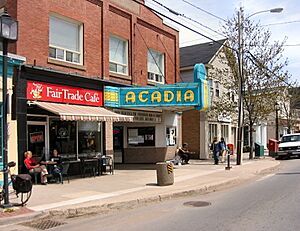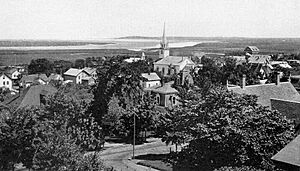Wolfville facts for kids
Quick facts for kids
Wolfville
|
|||||
|---|---|---|---|---|---|
|
Town
|
|||||

Wolfville streetscape, spring 2006. The view shows the Al Whittle (Acadia) Theatre, a house of movies and live performances now operated by a non-profit cooperative.
|
|||||
|
|||||
| Country | Canada | ||||
| Province | Nova Scotia | ||||
| County | Kings County | ||||
| Settled | 1755 | ||||
| Incorporated | March 4, 1893 | ||||
| Area | |||||
| • Land | 6.46 km2 (2.49 sq mi) | ||||
| Highest elevation | 92 m (302 ft) | ||||
| Lowest elevation | 0 m (0 ft) | ||||
| Population
(2021)
|
|||||
| • Total | 5,057 | ||||
| • Density | 783.3/km2 (2,029/sq mi) | ||||
| • Change (2016–21) | |||||
| Time zone | UTC-4 (AST) | ||||
| • Summer (DST) | UTC-3 (ADT) | ||||
| Postal code |
B4P
|
||||
| Area code(s) | 902 | ||||
| Telephone Exchange | 542, 585, 697 | ||||
| Median Earnings* | $36,979 | ||||
| NTS Map | 21H1 Wolfville | ||||
| GNBC Code | CBROD | ||||
|
|
|||||
Wolfville is a town in Nova Scotia, Canada. It is located in the Annapolis Valley in Kings County, Nova Scotia. The town is about 100 kilometers (62 miles) northwest of Halifax, the capital city of Nova Scotia.
Wolfville is home to Acadia University and Landmark East School. Many people visit Wolfville because of its beautiful views. You can see Cape Blomidon, the Bay of Fundy, and the Gaspereau Valley. The town is also known for its local wine industry. In downtown Wolfville, you will find many cafes, shops, and places to eat.
Wolfville has a special movie and performance hall called the Acadia Cinema Cooperative. This non-profit group runs the local theater. Some old Victorian houses in Wolfville have been turned into cozy bed and breakfast places for visitors to stay.
Contents
History of Wolfville
First Peoples in the Area
For a very long time, the area where Wolfville is now was a hunting ground for First Nations groups. These included the Clovis, Laurentian, Bear River, and Shields Archaic peoples. They came here for the salmon in the Gaspereau River. They also found agate stone at Cape Blomidon, which they used to make tools.
Many centuries ago, the Mi'kmaq people moved into Nova Scotia. They are related to the Algonquin and Ojibwe peoples. The Mi'kmaq were hunters who moved with the seasons. They used dogs and special snowshoes to hunt deer. They also used stones like jasper, quartz, and amethyst from the Blomidon area to make arrowheads.
French Settlement and Influence
In 1604, Pierre Dugua, Sieur de Mons and Samuel de Champlain tried to start a colony at Saint Croix Island, Maine. Later, they moved it to the Habitation at Port-Royal. The French and Mi'kmaq quickly started trading with each other. This trading relationship was good for both groups for many years. The French found that the area had many furs and rich, fertile land.
French settlement continued over time. In 1636, Port Royal was rebuilt under Charles de Menou d'Aulnay. This happened after Acadia (Nova Scotia) was given back to France by England. The people who settled here became known as the Acadians. By the late 1690s, about 350 Acadians lived in the area.
French families began settling in the Wolfville area around 1680. They were led by Pierre Melanson, who settled his family at Grand-Pré. The Acadians were successful farmers. They built special walls called dykes to protect the marshlands from the sea. This turned the land into rich fields for growing crops and raising animals.
In 1710, the French lost Acadia to the English after a battle at Annapolis Royal. In 1713, the Peace of Utrecht treaty officially gave Acadia to the British.
For the next 36 years, the British stayed mainly at Annapolis Royal. The number of French-speaking Catholic Acadians grew to over 10,000. The Minas region, which includes Wolfville, became the main Acadian settlement. Acadia was a border area between the British and French empires. This made life complicated for the Acadians. Both sides tried to get the Acadians to be loyal to them. Many Acadians tried to stay neutral.
During the Seven Years' War, the Acadians in the Wolfville area were forced to leave their homes. This event is known as the expulsion of the Acadians. Starting in September 1755, about 2,000 Acadians were deported by the British from the Wolfville area. British forces burned many Acadian villages. More buildings were destroyed during a guerrilla war that lasted until 1758.
British Rule and New Settlers
Around 1760, the British government in Nova Scotia offered land in the Annapolis Valley. They wanted English-speaking settlers to move there. The area of Grand-Pré and Wolfville became Horton Township. Many farmers from New England moved north to find good land at a fair price. Between 1760 and 1789, over 8,000 people, called New England Planters, moved to the Annapolis Valley. By 1763, 154 families lived in Horton Township.
The New England Planters focused on farming. They grew potatoes and grain, and later apples. They also worked in lumber and shipbuilding. They used the same dyke-lands that the Acadians had used before them. They fixed and expanded these dykes. In 1808, they built a large dyke called the Wickwire Dyke, which was three miles long. This helped them farm an extra 8,000 acres of land.
The first town site for Horton was planned near the Gaspereau River at Horton Landing. However, the town grew around the harbor on the Cornwallis River at Wolfville. It was first known as Mud Creek.
The first official Baptist church in Canada was the Horton Baptist Church. It was started on October 29, 1778, with help from Henry Alline. The Baptist faith remained strong in the area. In 1838, Acadia University was founded as a Baptist college.
In 1830, the town of Mud Creek changed its name to Wolfville. This was to honor Elisha DeWolf, who was the town's postmaster at the time. In the mid-1800s, Wolfville was known as the world's smallest port. The town became part of Canada when Canada was formed in 1867.
Wolfville in Canada
The Windsor and Annapolis Railway arrived in Wolfville in 1868. This railway later became the Dominion Atlantic Railway. Wolfville became an important port for shipping apples from the orchards of the Annapolis Valley.
Wolfville Harbour was also a stop for the MV Kipawo ferry. This ferry was the last in a long line of ferries that connected Wolfville, Kingsport, and Parrsboro for 200 years. The harbor is unique because it empties out twice a day due to the very high tides of the Bay of Fundy. The famous Robert Ripley once called it the smallest harbor in the world.
On March 20, 1893, Wolfville officially became an incorporated town. E. Perry Bowles was elected as its first mayor.
In 1985, the town was declared a nuclear free zone. Wolfville was also named Canada's first fair trade town on April 17, 2007. In May 2016, Wolfville became the third Cittaslow town in Canada. Cittaslow is a movement that promotes a slower pace of life in towns.
Population and People
| Historical population | ||
|---|---|---|
| Year | Pop. | ±% |
| 1956 | 2,497 | — |
| 1961 | 2,413 | −3.4% |
| 1981 | 3,235 | +34.1% |
| 1986 | 3,277 | +1.3% |
| 1991 | 3,475 | +6.0% |
| 1996 | 3,833 | +10.3% |
| 2001 | 3,658 | −4.6% |
| 2006 | 3,772 | +3.1% |
| 2011 | 4,269 | +13.2% |
| 2016 | 4,195 | −1.7% |
| 2021 | 5,057 | +20.5% |
In 2021, Wolfville had a population of 5,057 people. This was a 20.5% increase from its population in 2016. The town covers a land area of 6.46 square kilometers (2.5 square miles).
The population of Wolfville can change a lot during the year. This is because Acadia University has about 3,765 full-time students. Many students live in the town during the school year.
Arts and Culture
Wolfville has many cultural attractions. The Acadia University Art Gallery and The Festival Theatre are both on Main Street. You can also find many small restaurants and unique shops. The town's history is shown at the Randall House Museum, which is run by the Wolfville Historical Society.
Every year, the Annapolis Valley Music Festival takes place at Acadia Campus. Musicians from all over the valley come to compete. Wolfville also hosts two yearly arts festivals:
- The Deep Roots Music Festival in September.
- Devour! The Food Film Fest in late October.
The Al Whittle Theatre is a very important cultural spot in Wolfville. It opened in 1911 as an opera house. In 1923, it became a community theater and cinema. The theater closed in 2000, but it was reopened in 2004 by the Acadia Cinema Cooperative Ltd. It was named in honor of Al Whittle, a long-time manager. The theater is still a popular place for local plays and international independent films.
Wolfville also has a farmers market. It is located in the DeWolfe building, which used to be a warehouse for packing apples. In July 2022, the town hosted the first ever Annapolis Valley Pride Festival.
The town's library is called the Wolfville Memorial Library.
Education in Wolfville
Wolfville is home to several schools and a university:
- Acadia University
- Landmark East School
- Wolfville School
- Horton High School
Notable People from Wolfville
Many interesting people have connections to Wolfville:
- Joseph Barss, a privateer (a type of sailor who attacked enemy ships)
- Bob Chambers (1905–1996), a political cartoonist
- Alex Colville (1920–2013), an artist who worked during World War II
- Gilbert Lafayette Foster, the 6th Canadian Surgeon General
- William Hall (1827–1904), the third Canadian to receive the Victoria Cross, a very brave award.
- Arthur Chute McGill (1926–1980), a theologian and philosopher
- Mona Louise Parsons (1901–1976), a member of the Dutch resistance during World War II
Parks and Green Spaces
Wolfville has several parks where people can enjoy nature:
- Canada Parks
- Lumsden Pond Provincial Park
- Reservoir Park
- Rotary Park






